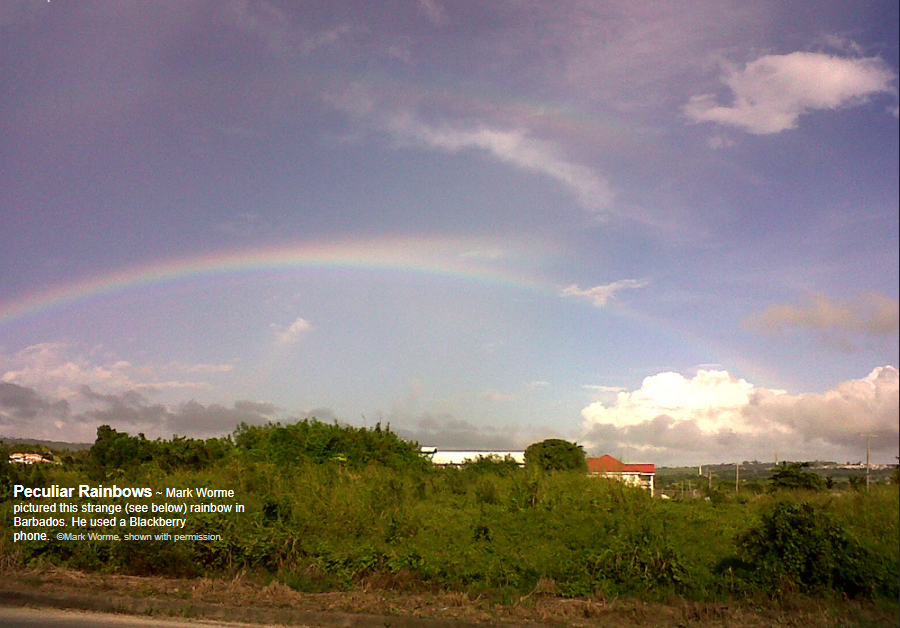OPOD - Another Peculiar Rainbow
OPOD - Another Peculiar Rainbow
Rainbows have always captivated us with their vibrant colors and elusive beauty. While they are a common occurrence after rainfall, occasionally, we are treated to a more peculiar and enigmatic display. One such example was captured by Mark Worme in Barbados, who managed to photograph a rather unusual rainbow using his Blackberry phone.
Unlike the typical split or twinned rainbows, this particular rainbow exhibited a fascinating twist. At the right-hand end, instead of a straight split, the rainbow curved upwards, creating a distinctive shape. Furthermore, upon closer examination of the enhanced image, it becomes apparent that the outer secondary bow is widened or partially split.
Typically, twinned rainbows feature a second bow below the primary, often less distinct, with an unsplit or disturbed secondary. However, this rainbow deviates from that pattern, leaving us perplexed about its true nature and origin. The possibility of it being a reflection bow can be ruled out since reflection bows do not intersect the primary in the same manner as this one.
One hypothesis that could potentially explain the split bow is the elongation of raindrops vertically, resembling prolate spheroids. This is in contrast to the flattened drops commonly used to explain ordinary twinned rainbows. However, it is important to note that formulating extraordinary hypotheses based on a single observation may not provide us with substantial insights or explanations.
As we delve deeper into the world of atmospheric optics, we encounter various phenomena that continue to challenge our understanding. While some optical phenomena have been extensively studied and well-explained, others remain shrouded in mystery. This peculiar rainbow falls into the latter category for now.
The beauty of atmospheric optics lies not only in the elegance of its well-known phenomena but also in the allure of the unexplained. Each new observation like this peculiar rainbow presents an opportunity for further exploration and discovery. Scientists and enthusiasts alike eagerly await the chance to unravel the secrets behind such captivating displays.
It is important to remember that atmospheric optics is a dynamic field, constantly evolving with new insights and discoveries. As technology advances and our understanding deepens, we may eventually shed light on the mysteries that currently elude us. Until then, we can marvel at the wonders of the natural world and the occasional enigmatic spectacles it presents.
In conclusion, the peculiar rainbow captured by Mark Worme in Barbados adds to the collection of optical phenomena that defy easy explanation. Its unique characteristics, such as the curved split and widened outer secondary bow, set it apart from the more familiar twinned rainbows. While we can speculate about potential explanations, this rainbow remains an intriguing puzzle waiting to be solved. As we continue to explore the realm of atmospheric optics, we embrace the uncertainty and excitement that comes with encountering these peculiar and unexplained phenomena.

Peculiar Rainbows ~ Mark Worme pictured this strange (see below) rainbow in Barbados. He used a Blackberry phone. ©Mark Worme, shown with permission.

Split or twinned rainbows are rare and transient yet there are several observations of them. This rainbow is different. The ‘split’ at the right hand end curves upwards. The grossly enhanced view of the same image at right hints also that the outer secondary bow is widened or partially split.
At lower left there is another view of the split primary taken several seconds later.
Twinned rainbows characteristically show a second bow, often less distinct, below the primary with an unsplit or disturbed secondary. This bow does not follow that pattern.
Is it a reflection bow? A reflection from water or wet surfaces can be ruled out because reflection bows do not intersect the primary in the manner of this one.
We could possibly explain the split bow by invoking raindrops elongated vertically like prolate spheroids (as compared to the flattened drops used to explain ordinary twinned rainbows). But extraordinary hypotheses based on a single observation are not very useful.
This rainbow, at least for now, likely joins those that remain unexplained.
Note: this article has been automatically converted from the old site and may not appear as intended. You can find the original article here.
Reference Atmospheric Optics
If you use any of the definitions, information, or data presented on Atmospheric Optics, please copy the link or reference below to properly credit us as the reference source. Thank you!
-
<a href="https://atoptics.co.uk/blog/opod-another-peculiar-rainbow/">OPOD - Another Peculiar Rainbow</a>
-
"OPOD - Another Peculiar Rainbow". Atmospheric Optics. Accessed on November 26, 2024. https://atoptics.co.uk/blog/opod-another-peculiar-rainbow/.
-
"OPOD - Another Peculiar Rainbow". Atmospheric Optics, https://atoptics.co.uk/blog/opod-another-peculiar-rainbow/. Accessed 26 November, 2024
-
OPOD - Another Peculiar Rainbow. Atmospheric Optics. Retrieved from https://atoptics.co.uk/blog/opod-another-peculiar-rainbow/.